Maine is a stunning state in the United States known for its rugged coastlines and picturesque mountains. It is also known for its diverse range of wildlife, including snakes. There are nine snakes native to Maine and none of them is venomous. This makes it an excellent state to visit if you love snakes as you can admire them without worrying about stumbling upon a dangerous one. If you’re out and about in Maine then you probably want to know which snakes are which, so let’s discover some of the black snakes in Maine!
1. Northern Water Snake (Nerodia sipedon)
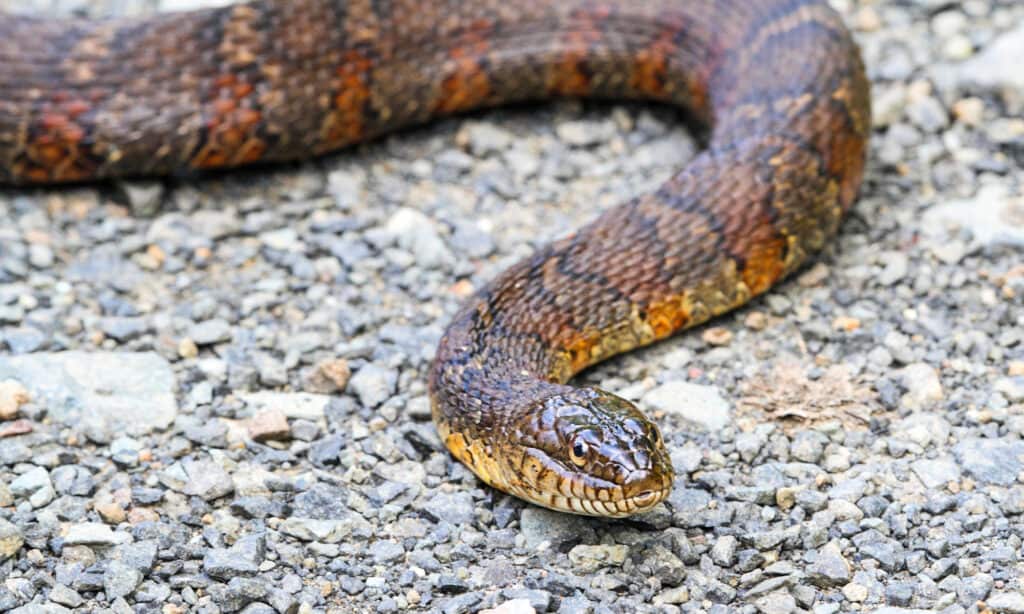
Northern water snakes are nonvenomous.
©Steve Byland/Shutterstock.com
We’ll kick off the list with the only water snake in the state – the northern water snake. Also known as the common water snake, this snake has a large, heavy body and can reach 4.5 feet long. Northern water snakes have keeled dorsal scales and are a dark, brownish-black color. This is overlaid with a series of darker crossband markings on their neck and blotches on their body. However, they typically darken with age so eventually, their markings become indistinguishable. Northern water snakes are semi-aquatic and live in and around most wetland habitats – such as swamps, streams, lakes, and slow-moving rivers.
Although they are not venomous, northern water snakes can be very aggressive if they are threatened or disturbed and will not hesitate to bite. Their appearance and aquatic nature often lead to them being mistaken for the venomous cottonmouth snake in other states. Northern water snakes are found mainly in the southern portion of Maine.
2. Ring-Necked Snake (Diadophis punctatus)
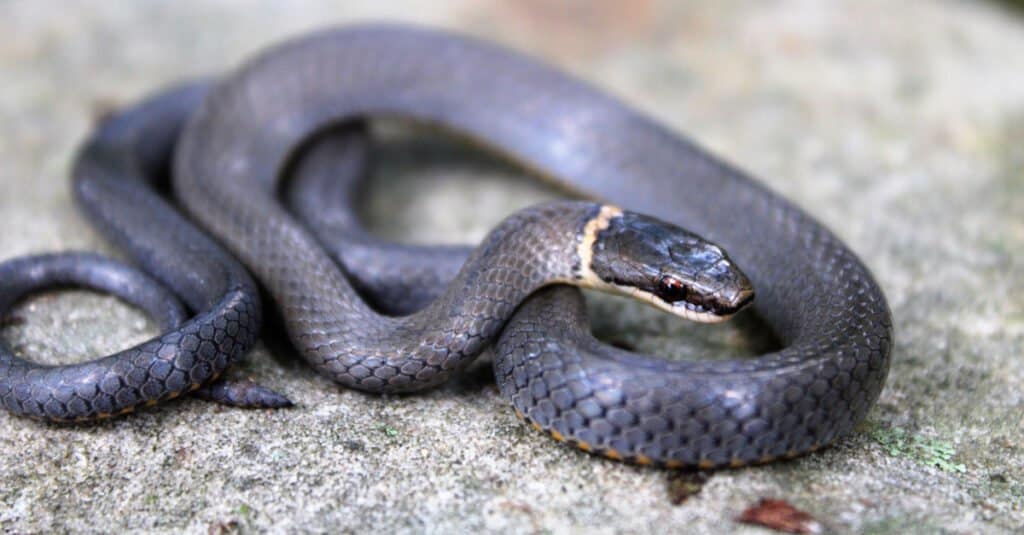
Ring-necked snakes are shy and secretive.
©Tucker Heptinstall/Shutterstock.com
A small but distinctive black snake in Maine is the ring-necked snake which only reaches 10 to 20 inches long. Ring-necked snakes have an incredibly distinctive appearance due to the presence of the brightly colored neck ring for which they are named. This can be either red, orange, or yellow while the rest of their body is a glossy black. However, sometimes their bellies are the same color as their neck ring, with the black remaining on their dorsal side.
Ring-necked snakes are widespread throughout most of Maine, with the exception of the northernmost region. Although they are common, they are shy and secretive which means that it is unlikely you will actually see one. Ring-necked snakes often live in forests or on hillsides where there is plenty of cover for them to hide underneath, such as rocks, logs, and decaying leaf litter. Although they are not dangerous to humans, ring-necked snakes are mildly venomous to their prey. They produce a venom-like substance from the Durvenoy gland and inject it using fangs at the rear of their mouth. Due to their small size, ring-necked snakes mainly eat earthworms, slugs, and salamanders.
3. Eastern Ribbon Snake (Thamnophis sauritus)
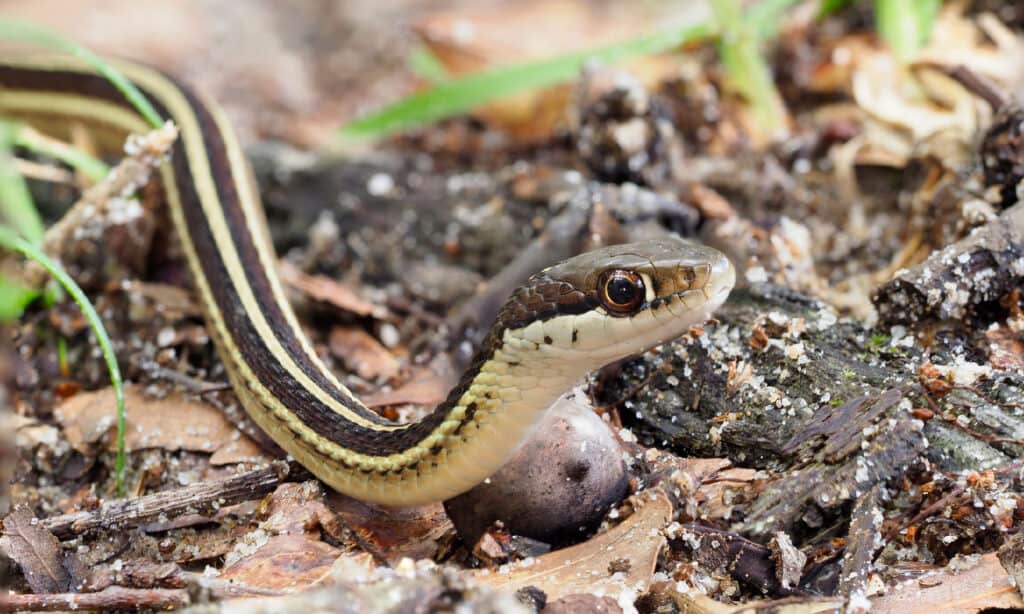
Eastern ribbon snakes live around water bodies.
©iStock.com/sdbower
The eastern ribbon snake is a subspecies of the ribbon snake which reaches 7 to 34 inches long. Eastern ribbon snakes have slender bodies with keeled dorsal scales. They are black with three yellow stripes – one on their back and one alone on either side. They also have a greenish-yellow belly and yellow bars in front of each eye. Eastern ribbon snakes live in and around shallow bodies of water such as ponds and streams. However, they only live in the central and southern regions of Maine and are a species of Special Concern in the state.
Eastern ribbon snakes are most likely to be seen during the day. They prey on a wide range of fish, amphibians, salamanders, and some insects. Although they are usually active all year round, eastern ribbon snakes sometimes overwinter in burrows or ant mounds.
4. Common Garter Snake (Thamnophis sirtalis)
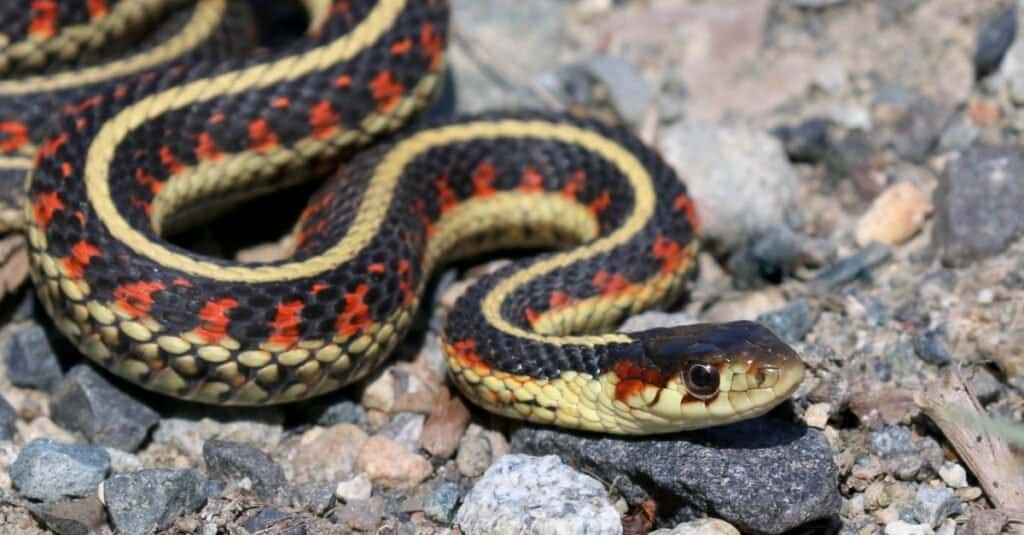
Garter snakes have large heads with small eyes.
©iStock.com/randimal
Another black snake in Maine is the common garter snake which is one of the most common and widespread snakes in the entire state. Common garter snakes have a similar appearance to the eastern ribbon snake which often leads to confusion between the two. These snakes are around 52 inches long and are typically black or brown with cream or yellow stripes. They also have small red markings down their sides and a plain, yellow-colored belly.
Common garter snakes live in a variety of habitats, such as forested uplands, grasslands, and rocky outcrops. However, they are also often found near wetland habitats, including swamps, streams, and ponds. Common garter snakes are not considered to be dangerous to humans but their saliva is mildly toxic and it can cause an itching or burning sensation. Incredibly, they are actually immune to the poison produced by toads.
5. Red-Bellied Snake (Storeria occipitomaculata)
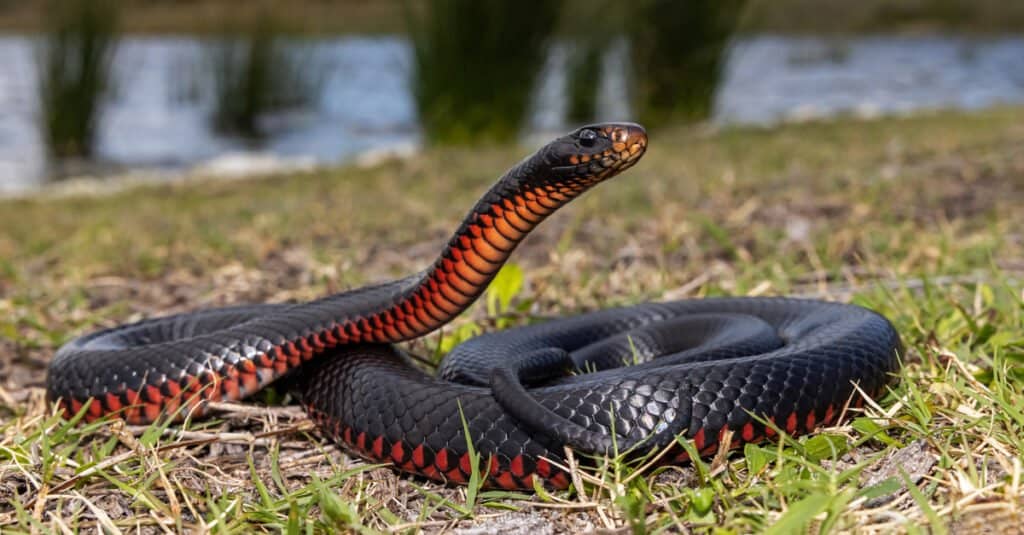
Red-bellied snakes only eat small animals.
©Ken Griffiths/Shutterstock.com
The red-bellied snake is often mistaken for the ring-necked snake. It is only 4 to 10 inches long and is typically black or grey with a bright red belly. Red-bellied snakes mainly live in forests and fields across Maine with the exception of the northernmost regions. They are shy and secretive snakes and prefer to hide away in the leaf litter or underneath logs and rocks.
Red-bellied snakes only eat small animals such as soft-bodied insects, worms, and slugs. They are not dangerous but can release a foul musky smell if they are threatened or handled.
6. Northern Black Racer (Coluber constrictor constrictor)
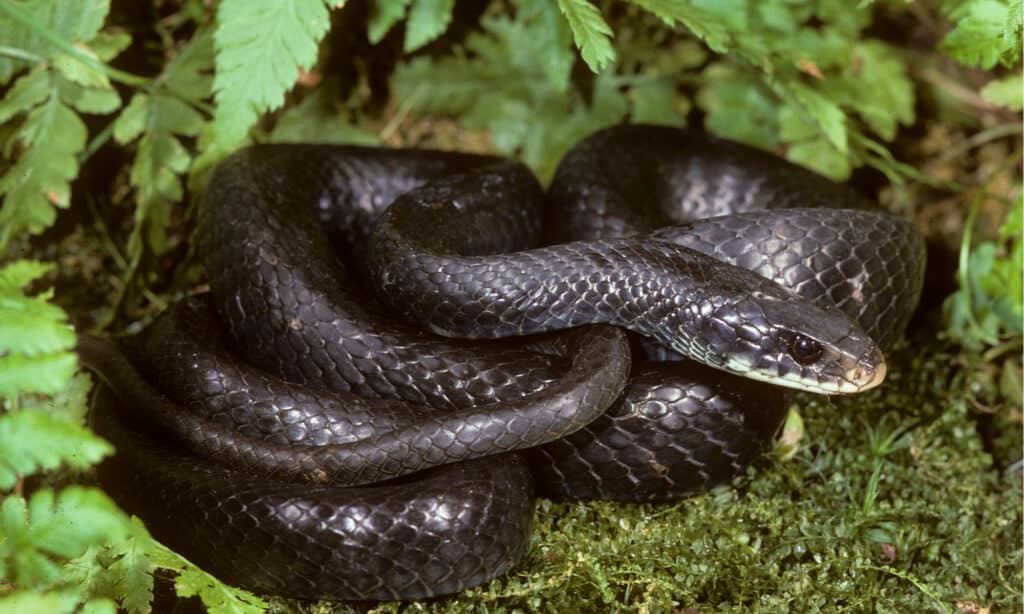
Northern black racers are endangered in Maine.
©Breck P. Kent/Shutterstock.com
The final black snake in Maine is the northern black racer which is a subspecies of the eastern racer. Northern black racers are the longest snakes in the state at 36 to 76 inches long. They are black with smooth scales which gives them a glossy appearance. They also have a white chin and throat. Although adults are easily distinguished, juveniles tend to be light grey with dark blotches on them which sometimes leads to confusion with other snakes, such as milk snakes.
Northern black racers live in dry woodlands and grasslands where they prey on rodents, birds, amphibians, and insects. They are quick, agile snakes and although they are not venomous they do bite if disturbed. However, northern black racers are an endangered species in Maine and are only found in the southernmost regions of the state.
Up Next
- Discover The 9 Largest Animals In Maine, And Where You’ll Find Them
- 9 Snakes in Maine (With Identification Guide And Pictures)
- The 5 Best Places To Camp In Maine This Summer
The photo featured at the top of this post is © iStock.com/Wildnerdpix
Discover the "Monster" Snake 5X Bigger than an Anaconda
Every day A-Z Animals sends out some of the most incredible facts in the world from our free newsletter. Want to discover the 10 most beautiful snakes in the world, a "snake island" where you're never more than 3 feet from danger, or a "monster" snake 5X larger than an anaconda? Then sign up right now and you'll start receiving our daily newsletter absolutely free.
Sources
- Maine Department of Inland Fisheries and Wildlife, Available here: https://www.maine.gov/ifw/fish-wildlife/wildlife/species-information/reptiles-amphibians/common-watersnake.html
- Maine Department of Inland Fisheries and Wildlife, Available here: https://www.maine.gov/ifw/fish-wildlife/wildlife/species-information/reptiles-amphibians/ring-necked-snake.html
- Maine Department of Inland Fisheries and Wildlife, Available here: https://www.maine.gov/ifw/fish-wildlife/wildlife/species-information/reptiles-amphibians/eastern-ribbonsnake.html
- Maine Department of Inland Fisheries and Wildlife, Available here: https://www.maine.gov/ifw/fish-wildlife/wildlife/species-information/reptiles-amphibians/north-american-racer.html
- Maine Department of Inland Fisheries and Wildlife, Available here: https://www.maine.gov/ifw/fish-wildlife/wildlife/species-information/reptiles-amphibians/common-gartersnake.html
- Maine Department of Inland Fisheries and Wildlife, Available here: https://www.maine.gov/ifw/fish-wildlife/wildlife/species-information/reptiles-amphibians/red-bellied-snake.html
Thank you for reading! Have some feedback for us? Contact the AZ Animals editorial team.






